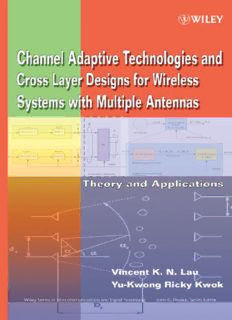
Channel-Adaptive Technologies and Cross-Layer Designs for Wireless Systems with Multiple Antennas: Theory and Applications PDF
Preview Channel-Adaptive Technologies and Cross-Layer Designs for Wireless Systems with Multiple Antennas: Theory and Applications
Channel-Adaptive Technologies and Cross-Layer Designs for Wireless Systems with Multiple Antennas Theory and Applications Vincent K. N. Lau The Hong Kong University of Science and Technology Yu Kwong Ricky Kwok The University of Hong Kong AJOHN WILEY & SONS, INC., PUBLICATION Channel-Adaptive Technologies and Cross-Layer Designs for Wireless Systems with Multiple Antennas Channel-Adaptive Technologies and Cross-Layer Designs for Wireless Systems with Multiple Antennas Theory and Applications Vincent K. N. Lau The Hong Kong University of Science and Technology Yu Kwong Ricky Kwok The University of Hong Kong AJOHN WILEY & SONS, INC., PUBLICATION Copyright © 2006 by John Wiley & Sons,Inc.All rights reserved. Published by John Wiley & Sons,Inc.,Hoboken,New Jersey. Published simultaneously in Canada. No part of this publication may be reproduced,stored in a retrieval system,or transmitted in any form or by any means,electronic,mechanical,photocopying,recording,scanning,or otherwise,except as permitted under Section 107 or 108 of the 1976 United States Copyright Act,without either the prior written permission of the Publisher,or authorization through payment of the appropriate per-copy fee to the Copyright Clearance Center,Inc.,222 Rosewood Drive,Danvers,MA 01923,(978) 750-8400,fax (978) 646-8600,or on the web at www.copyright.com.Requests to the Publisher for permission should be addressed to the Permissions Department,John Wiley & Sons,Inc.,111 River Street,Hoboken,NJ 07030, (201) 748-6011,fax (201) 748-6008,e-mail:[email protected] Limit of Liability/Disclaimer of Warranty:While the publisher and author have used their best efforts in preparing this book,they make no representations or warranties with respect to the accuracy or completeness of the contents of this book and specifically disclaim any implied warranties of merchantability or fitness for a particular purpose.No warranty may be created ore extended by sales representatives or written sales materials.The advice and strategies contained herin may not be suitable for your situation.You should consult with a professional where appropriate.Neither the publisher nor author shall be liable for any loss of profit or any other commercial damages,including but not limited to special,incidental,consequential,or other damages. For general information on our other products and services please contact our Customer Care Department with the U.S.at 877-762-2974,outside the U.S.at 317-572-3993 or fax 317-572-4002. Wiley also publishes its books in a variety of electronic formats.Some content that appears in print,however,may not be available in electronic format. Library of Congress Cataloging-in-Publication Data: Lau,Vincent K.N. Channel adaptive technologies and cross layer designs for wireless systems with multiple antennas :theory and applications / Vincent K.N.Lau,Yu-Kwong Ricky Kwok. p. cm. ISBN-13:978-0-471-64865-9 ISBN-10:0-471-64865-5 1. Wireless communication systems—Design and construction. I. Kwok,Yu-Kwong Ricky. II. Title. TK5103.4.L56 2006 2005043673 Printed in the United States of America. 10 9 8 7 6 5 4 3 2 1 To our wives:Elvina and Fion CONTENTS List of Figures xvii List of Tables xxv Preface xxvii Acknowledgments xxxv PART 1 THEORY 1 Chapter 1 Basic Concepts in Wireless Communications 3 1.1 Overview 3 1.2 Wireless Channel Models 3 1.2.1 AWGN Channel Model 4 1.2.2 Linear Time-Varying Deterministic Spatial Channel 4 1.2.3 The Random Channels 12 1.2.4 Frequency-Flat Fading Channels 17 1.2.5 Frequency-Selective Fading Channels 18 1.3 Equivalence of Continuous-Time and Discrete-Time Models 19 1.3.1 Concepts of Signal Space 20 1.3.2 Sufficient Statistics 20 1.3.3 Discrete-Time Signal Model—Flat Fading 20 1.3.4 Discrete-Time Channel Model—Frequency-Selective Fading 28 1.4 Fundamentals of Information Theory 30 1.4.1 Entropy and Mutual Information 31 1.4.2 Shannon’s Channel Coding Theorem 36 1.4.3 Examples of Channel Capacity 46 1.5 Summary 54 Exercises 54 vii viii CONTENTS Chapter 2 MIMO Link with Perfect Channel State Information 59 2.1 Overview 59 2.2 Mathematical Model of the MIMO Link 60 2.2.1 Probabilistic Channels with States 61 2.2.2 General Transmission and CSI Feedback Model 64 2.2.3 Adaptive-Channel Encoding and Decoding 65 2.2.4 Transmit Power Constraint 66 2.2.5 Causal Feedback Constraint 67 2.3 Ergodic and Outage Channel Capacity 67 2.3.1 Ergodic Capacity 68 2.3.2 Outage Capacity 68 2.4 Channel Capacity with No CSIT and No CSIR 69 2.4.1 Fast Flat Fading MIMO Channels 70 2.4.2 Block Fading Channels 70 2.5 Channel Capacity with Perfect CSIR 72 2.5.1 Block Fading Channels 73 2.5.2 Fast Flat Fading MIMO Channels 76 2.5.3 Effect of Antenna Correlation on Ergodic MIMO Capacity 81 2.5.4 Slow Flat Fading MIMO Channels 87 2.6 Channel Capacity with Perfect CSIT Only 89 2.6.1 Discrete Block Fading Channels 91 2.6.2 Discrete Channel with Three States 93 2.6.3 Fast Flat Fading MIMO Channels 94 2.6.4 Slow Flat Fading MIMO Channels 94 2.7 Channel Capacity with Perfect CSIR and Perfect CSIT 95 2.7.1 Fast Flat Fading MIMO Channels 96 2.7.2 Slow Flat Fading MIMO Channels 100 2.8 Summary 101 Exercises 103 Chapter 3 MIMO Link with Imperfect Channel State Information 107 3.1 Overview 107 3.2 Effect of Imperfect CSI Estimation 108 3.2.1 CSI Estimation for MIMO Channels 108 3.2.2 Capacity Bounds of MIMO Link 109 3.3 Effect of Limited Feedback—Optimizing for SNR 111 3.3.1 Introduction to Optimizing Effective SNR 112 3.3.2 Grassmannian Line Packing 112
Description: